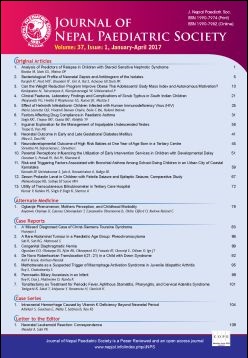De Novo Robertsonian Translocation t(21; 21) in a Child with Down Syndrome
DOI:
https://doi.org/10.3126/jnps.v37i1.16184Keywords:
Aneuploidy, pre-conception genetic diagnosis, genetic counselling, trisomyAbstract
The phenotypic expression in DS is determined by the type of underlying cytogenetic abnormality. Almost 90-95% cases of DS are due to pure trisomy of the 21st chromosome; 6-7% is the result of mosaicism and in only 3-5% of cases it results from Robertsonian translocation (ROB). About 1/3rd cases of unbalanced Robertsonian translocation causing DS are inherited. We report a 1-year-old-boy with DS secondary to rea(21;21) ROB.Downloads
Downloads
Published
How to Cite
Issue
Section
License
Authors who publish with this journal agree to the following terms:
Authors retain copyright and grant the journal right of first publication with the work simultaneously licensed under a Creative Commons Attribution License that allows others to share the work with an acknowledgement of the work's authorship and initial publication in this journal.
Authors are able to enter into separate, additional contractual arrangements for the non-exclusive distribution of the journal's published version of the work (e.g., post it to an institutional repository or publish it in a book), with an acknowledgement of its initial publication in this journal.
Authors are permitted and encouraged to post their work online (e.g., in institutional repositories or on their website) prior to and during the submission process, as it can lead to productive exchanges, as well as earlier and greater citation of published work (See The Effect of Open Access).



